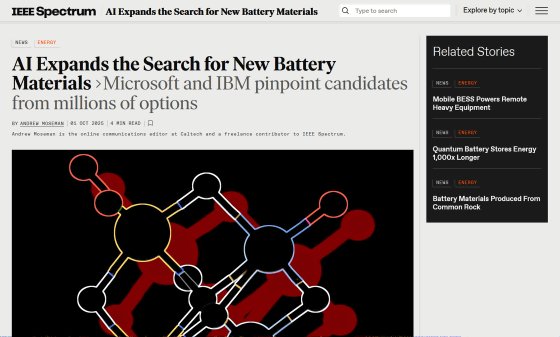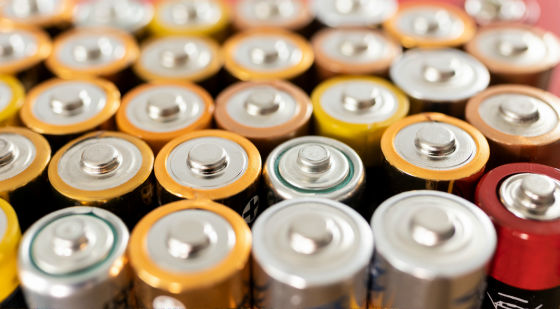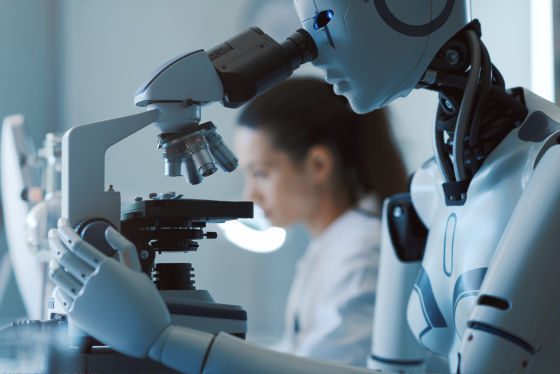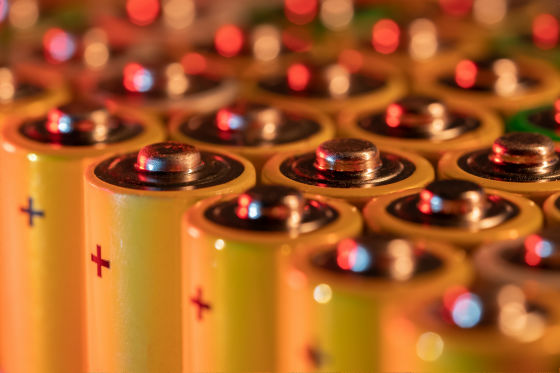Microsoft and IBM are using AI to narrow down the options for new battery materials

As batteries become more prevalent in modern society, discovering more efficient battery materials is becoming increasingly important. Major technology companies, including Microsoft and IBM, are using AI to explore new battery materials, according to a report from IEEE Spectrum, a website operated by the Institute of Electrical and Electronics Engineers (IEEE).
AI Drives Battery Innovation at Microsoft, IBM - IEEE Spectrum

Among battery materials, electrolytes play a key role in battery performance and safety. A Microsoft research team is using AI to identify new electrolyte candidates for rechargeable batteries. In 2023, they discovered a new material that could reduce the amount of lithium needed in rechargeable lithium-ion batteries by approximately 70%. By leveraging the power of AI models, the research team identified promising candidates from approximately 32.5 million candidates in just 80 hours. At the time of writing, a research team at Pacific Northwest National Laboratory (PNC) is planning to synthesize the newly discovered material, NaxLi3−xYCl6 , and test it in battery structures.
Microsoft discovers material that can replace about 70% of lithium in batteries in just a few days, running simulations and AI models using Azure Quantum Elements - GIGAZINE

'Our goal was to demonstrate the potential for accelerating scientific discovery using one of these AI models,' said Nathan Baker, project lead for Azure Quantum Elements, a Microsoft program that accelerates chemical and materials research through advanced computing and AI platforms. 'We demonstrated that we could screen 32.5 million potential materials and complete the task in tens of hours instead of years.'
The AI model, called the M3GNet framework, developed by Microsoft researchers accelerates molecular dynamics simulations to evaluate material properties such as atomic diffusivity. The researchers first used the AI model to introduce new combinations of chemical elements into known crystal structures and determine which of the resulting molecules are stable. This narrowed the list of 32.5 million potential materials down to 500,000.
The AI model then screened these candidate materials based on the chemical properties required for battery operation, narrowing the list down to just 800. A combination of traditional computing and good old-fashioned human expertise then led to the final identification of NaxLi3−xYCl6.

Researchers around the world, including Microsoft, are using AI to explore materials that can replace rare elements used in lithium-ion batteries, reduce their hazards, or improve their performance.
In August 2025, New Jersey Institute of Technology associate professor
The approach of using AI models to explore the nearly infinite space of potential materials is a turning point in the field. Austin Sendek, a professor at Stanford University who has developed an AI algorithm to help discover new battery materials, argues that it is important to find a compromise between a model that runs quickly and one that provides accurate results.
Sendek pointed out that AI models for materials exploration need both breadth and depth. Breadth refers to applying knowledge across the entire infinite chemical space, while depth refers to vast, detailed scientific knowledge about materials properties, engineering, and chemistry. 'That's where the potential of AI lies,' Sendek said.

In a paper published in 2025, IBM researchers announced that they had used an AI-based approach to identify a new electrolyte candidate with significantly higher ionic conductivity than the electrolytes used in existing batteries. A typical electrolyte contains six to eight components, including salts, solvents, and additives, making it nearly impossible to consider all the combinations without AI.
To narrow down promising electrolyte candidates, the researchers built a fundamental chemical model trained on billions of molecules. By training this model with battery-related data, the AI can predict key properties for battery applications at scales ranging from individual molecules to entire devices.
Younghae Na , a principal scientist at IBM Research, believes this research has a much greater potential to contribute to future battery development because it explores new combinations of existing materials rather than developing a unique new material. The research team is currently working with an undisclosed electric vehicle manufacturer to design electrolyte materials for high-voltage batteries.
IBM researchers are using AI not only to identify promising materials but also to test the materials they synthesize. They are building virtual models (digital twins) that predict how a particular battery composition will degrade over its lifetime, predicting the battery's long-term behavior after a small number of charging cycles.

The next phase of AI-based battery research is quantum computing , and both Microsoft and IBM believe quantum computers may be able to model complex chemical reactions. Baker said, 'It's well-known that conventional computers have problems generating accurate answers for complex substances, molecules, and materials. So our goal now is to incorporate quantum technology into the generation process to obtain more accurate data for training machine learning.'
Related Posts:
in Science, Posted by log1h_ik






